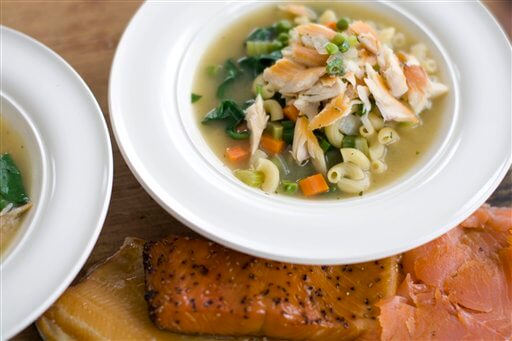
Several thousand years ago, people discovered that exposing fish to intense amounts of salt and smoke was a great was of preserving the catch for later.
Today, our smoking techniques are considerably more refined, and we do it more for flavor than as a means of preservation. And that makes it a shame more people don’t think to reach for smoked fish as an effortless way to add gobs of flavor to the foods they love.
But first, a primer on smoked fish. There are two ways to smoke fish — cold and hot. Salmon, trout, haddock and mackerel are the most common choices.
In cold smoking, the fish are brined in a heavy salt solution, then exposed to cool smoke (85 F max) for up to several days, then frozen to kill parasites. Cold smoked fish — which is essentially raw — has a soft, delicate texture, an assertive saltiness and a pleasant, but not overwhelming, smoky flavor.
Hot smoked fish is more lightly brined, then smoked for a shorter time at a higher temperature (as high as 170 F), effectively cooking the fish. Hot smoking produces a fish with a more assertive smoky flavor and a meatier texture (though the lighter brine means it isn’t as salty).
Both varieties often are seasoned, sometimes with just a bit of sugar, but also with black pepper, dill or other herbs.
As long as you keep in mind the differences in saltiness and smokiness, hot and cold smoked fish often can be used interchangeably in recipes. Generally, neither variety should be exposed to long cooking times, especially hot smoked fish, which already is cooked.
The exception to this is certain baked recipes, such as fishcakes and fish pot pies, which usually contain enough moisture to prevent the fish from getting tough.
Grocers generally sell a wide variety of both types of smoked fish. Salmon, for example, can be found with different seasonings and cuts, including thinly sliced, thick slabs and whole sides. Smoked salmon is particularly good for making dips and pates. When doing so, look for cheaper packages labeled “trimmings,” which are small pieces. Thinly sliced salmon is delicious topped with poached eggs and fresh dill.
Hot smoked fish, such as trout and mackerel, are delicious flaked into salads or tossed with warm pasta, especially with a cream sauce.
For more ideas for using smoked fish, check out the Off the Beaten Aisle column over on Food Network: http://bit.ly/RsyCqE
___
SMOKED TROUT NOODLE SOUP
Not as strange as it sounds. Smoked trout has a meaty texture similar to chicken. And the rich, smoky flavor is the perfect match for a soup thick with noodles.
Start to finish: 30 minutes
Servings: 6
2 tablespoons olive oil
1 clove garlic, minced
3 medium carrots, peeled and chopped
1 large yellow onion, diced
2 stalks celery, chopped
1 cup frozen peas
1 tablespoon chopped fresh thyme
Large sprig fresh rosemary
6 cups (1 1/2 quarts) chicken broth
2 cups elbow pasta
2 cups baby spinach
2 scallions, whites and greens, chopped
Salt and ground black pepper
8-ounce package smoked trout
In a large saucepan over medium-high, heat the oil. Add the garlic, carrots, onion, celery, peas, thyme and rosemary. Saute for 5 minutes.
Add the chicken broth and bring to a simmer. Add the pasta and cook for 7 to 8 minutes, or until barely tender. Remove and discard the rosemary stem. Add the spinach and scallions and heat for 30 seconds. Season with salt and pepper.
Using a fork, flake and break up the trout into large bite-size chunks. Ladle the soup into serving bowls, then pile a bit of the trout in the center of each.
Nutrition information per serving (values are rounded to the nearest whole number): 320 calories; 80 calories from fat (25 percent of total calories); 9 g fat (2 g saturated; 0 g trans fats); 35 mg cholesterol; 41 g carbohydrate; 18 g protein; 5 g fiber; 630 mg sodium.



































